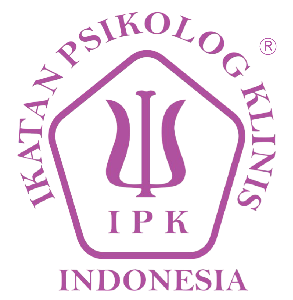Psikoeduakasi C4ME Untuk Mengatasi Gangguan Sindrom Pramenstruasi Pada Taruni Militer
DOI:
https://doi.org/10.26740/jptt.v11n1.p32-46Keywords:
Psikoedukasi C4ME, sindrom pramenstruasi, taruni militerAbstract
Different situations and lifestyles in the military education academy require the women Navy cadets to adapt to high levels of stress. Stress can potentially disrupt the menstrual cycle and worsen the symptoms of premenstrual syndrome (PMS) which can reduce their performance as military cadets. This study aims to determine the effect of psychoeducation of Care For Menstruation (C4ME) on overcoming PMS problems in the Navy Academy. C4ME covers health counseling activities that provide information about menstruation and involves interventions based on cognitive-behavioral techniques to cope with PMS symptoms. This quasi-experiment used non-randomized one-group pretest-posttest design. Fifteen women Navy cadets were recruited. Quantitative data were collected using questionnaires of knowledge and attitude towards menstruation and were analyzed using a parametric statistical t-correlated sample. Qualitative data were collected from interviews before and after the intervention and were analyzed using a content analysis. The results show that C4ME psychoeducation is effective in increasing knowledge of menstruation (p = 0.01), changing participants' attitudes toward menstruation being more positive (p <0.01) and decreasing the symptoms of PMS experienced by participants.
Keywords: C4ME Psychoeducation, premenstrual syndrome, women navy cadet
Abstrak: Perbedaan situasi dan gaya hidup di akademi pendidikan militer menuntut para taruni Akademi Angkatan Laut (AAL) untuk beradaptasi dengan level stres yang tinggi. Stres berpotensi dapat mengganggu siklus menstruasi dan memperparah gejala sindrom pramenstruasi (PMS) yang dapat menurunkan produktifitas taruni. Penelitian ini bertujuan untuk menguji pengaruh psikoedukasi Care For Menstruation (C4ME) dalam mengatasi masalah PMS pada taruni AAL. Program psikoedukasi meliputi kegiatan penyuluhan kesehatan dan intervensi dengan teknik kognitif-perilaku untuk mengatasi gejala PMS. Metode kuasi-eksperimen dengan non-randomized design one-grup pretest-posttest digunakan. Partisipan penelitian adalah lima belas orang taruni AAL. Data kuantitatif tentang pengetahuan dan sikap terhadap menstruasi diukur menggunakan kuesioner, sedangkan data kualitatif diperoleh melalui wawancara sebelum dan sesudah dilakukan intervensi. Data kuantitatif dianalisis dengan statistik parametrik t-correlated sample, sedangkan data kualitatif dianalisis menggunakan analisis konten. Hasil menunjukkan bahwa psikoedukasi tentang menstruasi efektif dalam meningkatkan pengetahuan (p=0,01), mengubah sikap partisipan menjadi lebih positif terhadap menstruasi (p<=0,01), dan menurunkan gejala PMS pada para taruni.
References
Brabender, V. A., Fallon, A. E., & Smolar, A. I. (2004). Essential of group therapy.New Jersey : John Wiley & Sons,Inc.
Bashiri, Z., Aghajani, M., & Alavi, N. M. (2016). Effects of psychoeducation on mental health in patients with coronary heart disease. Iranian Red Crescent Medical Journal, 18(5). e25089. https://doi.org/10.5812/ircmj.25089
Blake, F. (1995). Cognitive therapy for Premenstrual Syndrome. Cognitive and Behavioral Practice, 2(1), 167185. https://doi.org/10.1016/S1077-7229(05)80009-4
Bluth, K., Gaylord, S., Nguyen, K., Bunevicius, A., & Girdler, S. (2015). Mindfulness-Based Stress Reduction as a Promising Intervention for Amelioration of Premenstrual Dysphoric Disorder Symptoms. Mindfulness. 6(6): 12921302. https://doi.org/10.1007/s12671-015-0397-4
Budarapu, S., Sadam, H., Harshitha, K., Nageswari M D., Reddy K, H., & Dhanekula, G. (2018). Section¯: Psychiatry A Study to Assess the Prevalence of Premenstrual Syndrome and Premenstrual Dysphoric Disorder and Various Coping Strategies used by Students in A Womens Medical College from South India. International Journal of Contemporary Medical Research 5(11), K1K5. http://dx.doi.org/10.21276/ijcmr.2018.5.11.18
Chau, J. P. C., & Chang, A. M. (1999). Effects of an educational programme on adolescents with premenstrual syndrome. Health Education Research, 14(6), 817830. https://doi.org/10.1093/HER/14.6.817
Chrisler, J. C. (2008). 2007 Presidential address: Fear of losing control: Power, perfectionism, and the psychology of women. Psychology of Women Quarterly, 32(1),112. https://doi.org/10.1111/j.1471-6402.2007.00402.x
Chrisler, J. C., Gorman, J. A., & Streckfuss, L. (2014). Self-Silencing, Perfectionism, Dualistic Discourse, Loss of Control, and the Experience of Premenstrual Syndrome. Womens Reproductive Health, 1(2), 138152. https://doi.org/10.1080/23293691.2014.966597
Do, J. J., Samuels, S. M., Adkins, D. J., Clinard, M. E., & Koveleskie, A. J. (2013). Gender bias and pluralistic ignorance in perceptions of fitness assessments. Military Psychology, 25(1), 2335. https://doi.org/10.1037/h0094754
Eriksson, M., Ghazinour, M., & Hammarström, A. (2018). Different uses of Bronfenbrenners ecological theory in public mental health research: what is their value for guiding public mental health policy and practice? Social Theory and Health, 16(4), 414433. https://doi.org/10.1057/s41285-018-0065-6
Estiani, K., & Nindya, T. S. (2018). Hubungan Status Gizi Dan Asupan Magnesium Dengan Kejadian Premenstrual Syndrome (Pms) Pada Remaja Putri. Media Gizi Indonesia, 13(1), 20. https://doi.org/10.20473/mgi.v13i1.20-26
Forrester-Knauss, C., Zemp Stutz, E., Weiss, C., & Tschudin, S. (2011). The interrelation between premenstrual syndrome and major depression: Results from a population-based sample. BMC Public Health, 11. 795. https://doi.org/10.1186/1471-2458-11-795
Ghafoori, B., Fisher, D., Korosteleva, O., & Hong, M. (2016). A Randomized, Controlled Pilot Study of a Single-Session Psychoeducation Treatment for Urban, Culturally Diverse, Trauma-Exposed Adults. Journal of Nervous and Mental Disease, 204(6), 421430. https://doi.org/10.1097/NMD.0000000000000512
Harms, P. D., Krasikova, D. V., Vanhove, A. J., Herian, M. N., & Lester, P. B. (2013). Stress and emotional well-being in military organizations. Research in Occupational Stress and Well Being, 11, 103132. https://doi.org/10.1108/S1479-3555(2013)0000011008
Hosey, M., McWhorter, J. W., & Wegener, S. T. (2018). Psychologic Interventions for Chronic Pain. In Essentials of Pain Medicine (pp. 539-544.e1) https://doi.org/10.1016/b978-0-323-40196-8.00059-0
Hourani, L. L., Yuan, H., & Bray, R. M. (2004). Psychosocial and lifestyle correlates of premenstrual symptoms among military women. Journal of Womens Health. 13(7), 812821. https://doi.org/10.1089/jwh.2004.13.812
Ilagan, G., Ilagan, J., Simpson, A. N., Shealy, T., Bennett-Mintz, J., & McCormick, K. (2016). Outcomes from an Undergraduate Cadet Womens Backpacking Experience. Research in Outdoor Education, 14(1), 2140. https://doi.org/10.1353/roe.2016.0001
Jiang, L., Drolet, A., & Kim, H. S. (2018). Age and Social Support Seeking: Understanding the Role of Perceived Social Costs to Others. Personality and Social Psychology Bulletin, 44(7), 11041116. https://doi.org/10.1177/0146167218760798
Kang, H. W., Park, M., & Wallace (Hernandez), J. P. (2016). The impact of perceived social support, loneliness, and physical activity on quality of life in South Korean older adults. Journal of Sport and Health Science, 7(2), 237244. https://doi.org/10.1016/j.jshs.2016.05.003
Karimi, Z., Dehkordi, M. A., Alipour, A., & Mohtashami, T. (2018). Treatment of premenstrual syndrome: Appraising the effectiveness of cognitive behavioral therapy in addition to calcium supplement plus vitamin D. PsyCh Journal, 7(1), 4150. https://doi.org/10.1002/pchj.206
Darestani, M. K., Komeili, A., & Jalili, Z. (2017). The Effect of Educational Intervention Based on The Health Belief Model on Improvement of Preventive Behaviors Towards Premenstrual Syndrome (PMS) Among Girls of Pre-University in Tehran. Nian Journal of Health Education and Health Promotion, 05(03), 251259. https://doi.org/10.30699/acadpub.ijhehp.5.3.251
King, M., & Ussher, J. M. (2013). Its not all bad: Womens construction and lived experience of positive premenstrual change. Feminism and Psychology, 23(3), 399417. https://doi.org/10.1177/0959353512440351
Kleinstäuber, M., Schmelzer, K., Ditzen, B., Andersson, G., Hiller, W., & Weise, C. (2016). Psychosocial Profile of Women with Premenstrual Syndrome and Healthy Controls: A Comparative Study. International Journal of Behavioral Medicine, 23(6). 752763. https://doi.org/10.1007/s12529-016-9564-9
Lustyk, M. K. B., Gerrish, W. G., Douglas, H., Bowen, S., & Marlatt, G. A. (2011). Relationships Among Premenstrual Symptom Reports, Menstrual Attitudes, and Mindfulness. Mindfulness, 2(1), 3748. https://doi.org/10.1007/s12671-011-0041-x
Lustyk, M. K. B., Gerrish, W. G., Shaver, S., & Keys, S. L. (2009). Cognitive-behavioral therapy for premenstrual syndrome and premenstrual dysphoric disorder: A systematic review. Archives of Womens Mental Health, 12(2), 8596. https://doi.org/10.1007/s00737-009-0052-y
Maddineshat, M., Keyvanloo, S., Lashkardoost, H., Arki, M., & Tabatabaeichehr, M. (2016). Effectiveness of group cognitive-behavioral therapy on symptoms of premenstrual syndrome (PMS). Iranian Journal of Psychiatry, 11(1), 3036. https://www.ncbi.nlm.nih.gov/pmc/articles/PMC4888138/pdf/IJPS-11-30.pdf
McAllister, L., Callaghan, J. E. M., & Fellin, L. C. (2019). Masculinities and emotional expression in UK servicemen: ˜Big boys dont cry? Journal of Gender Studies, 28(3), 257270. https://doi.org/10.1080/09589236.2018.1429898
Nakkas, C., Annen, H., & Brand, S. (2016). Psychological distress and coping in military cadre candidates. Neuropsychiatric Disease and Treatment, 12, 22372243. https://doi.org/10.2147/NDT.S113220
Namsa,A.M., Palandeng,H., & Kallo,V.D.(2015). Hubungan status gizi dengan sindrom premenstruasi pada remaja putri di SMA Frater Don Bosco Manado. e-Jurnal Keperawatan, 3(3), 1-7. https://ejournal.unsrat.ac.id/index.php/jkp/article/view/8780
Nashruna ,I.,Maryatum, & Wulandari, R. (2012). Hubungan aktivitas olahraga dan obesitas dengan kejadian sindrom pramenstruasi di Desa Puncangmiliar Tulung Klaten. Jurnal Gaster. 9(1). 65-75. https://jurnal.aiska-university.ac.id/index.php/gaster/article/view/33
Perz, J., & Ussher, J. M. (2006). Womens experience of premenstrual syndrome: A case of silencing the self. Journal of Reproductive and Infant Psychology, 24(4), 289303. https://doi.org/10.1080/02646830600973883
Marasigan, P. R. (2019). Using brief cognitive restructuring and cognitive defusin technique to cope with negative thoughts. Social Values and Society, 1(4), 1114. https://doi.org/10.26480/svs.04.2019.11.14
Rahmani, F., Ranjbar, F., Ebrahimi, H., & Hosseinzadeh, M. (2015). The Effects of Group Psychoeducational Programme on Attitude toward Mental Illness in Families of Patients with Schizophrenia, 2014. Journal of Caring Sciences, 4(3), 243251. https://doi.org/10.15171/jcs.2015.025
Ramadani, M. (2012). Premenstrual syndrome (PMS). Jurnal Kesehatan Masyarakat.,7(1), 21-25. http://jurnal.fkm.unand.ac.id/index.php/jkma/article/view/103/109
Rapkin, A. J., & Lewis, E. I. (2013, November). Treatment of premenstrual dysphoric disorder. Womens Health, 9(6), 537-56. https://doi.org/10.2217/whe.13.62
Read, J. R., Perz, J., & Ussher, J. M. (2014). Ways of coping with premenstrual change: Development and validation of a premenstrual coping measure. BMC Womens Health, 14(1), 115. https://doi.org/10.1186/1472-6874-14-1
Reberte, L. M., de Andrade, J. H. C., Hoga, L. A. K., Rudge, T., & Rodolpho, J. R. C. (2014). Mens Perceptions and Attitudes Toward the Partner With Premenstrual Syndrome. American Journal of Mens Health, 8(2), 137147. https://doi.org/10.1177/1557988313497050
Rezaee, H., Mahamed, F., & Amidi Mazaheri, M. (2015). Does Spousal Support Can Decrease Womens Premenstrual Syndrome Symptoms? Global Journal of Health Science, 8(5), 19-26. https://doi.org/10.5539/gjhs.v8n5p19
Sawilowsky, S. (2009). New Effect Size Rules of Thumb. Journal of Modern Applied Statistical Methods, 8(2). 597-599. https://doi.org/10.22237/jmasm/1257035100
Siahbazi, S., Montazeri, A., Taghizadeh, Z., & Masoomie, R. (2018). The Consequences of Premenstrual Syndrome on the Quality of Life from the Perspective of Affected Women: A Qualitative Study. Journal of Research in Medical and Dental Science, 6(2), 284292. https://doi.org/10.5455/jrmds.20186243
Sigmon, S. T., Craner, J., Yoon, K. L., & Thorpe, G. L. (2012). Premenstrual Syndrome (PMS). Encyclopedia of Human Behavior: Second Edition, 7(1), 167173. https://doi.org/10.1016/B978-0-12-375000-6.00288-3
Taghizadeh, Z., Shirmohammadi, M., Feizi, A., & Arbabi, M. (2013). The effect of cognitive behavioural psycho-education on premenstrual syndrome and related symptoms. Journal of Psychiatric and Mental Health Nursing, 20(8),705713 https://doi.org/10.1111/j.1365-2850.2012.01965.x
Ussher, J. M., & Perz, J. (2010). Gender differences in self-silencing and psychological distress in informal cancer carers. Psychology of Women Quarterly, 34(2), 228242. https://doi.org/10.1111/j.1471-6402.2010.01564.x
Ussher, J. M., & Perz, J. (2013). PMS as a process of negotiation: Womens experience and management of premenstrual distress. Psychology and Health, 28(8), 909-27 https://doi.org/10.1080/08870446.2013.765004
Yadav, R. N., Joshi, S., Poudel, R., & Pandeya, P. (2018). Knowledge, Attitude, and Practice on Menstrual Hygiene Management among School Adolescents. Journal of Nepal Health Research Council, 15(3), 212216. https://doi.org/10.3126/jnhrc.v15i3.18842
Yuwanto, L. (2012). Pengantar metode penelitian. Jakarta: Dwi Putra Pustaka Jaya
Zendehdel, M., & Elyasi, F. (2018). Biopsychosocial etiology of premenstrual syndrome: A narrative review. Journal of Family Medicine and Primary Care, 7(2), 346-356. https://doi.org/10.4103/jfmpc.jfmpc_336_17
Downloads
Published
How to Cite
Issue
Section
License
Authors who publish in this journal agree to the following terms:
Copyright in any article is held by the author.
The author grants the journal, publication rights with the work simultaneously licensed under a Creative Commons Attribution License that allows others to share the work with an acknowledgment of the work's authorship and initial publication in this journal.
Authors may enter into separate, additional contractual arrangements for the non-exclusive distribution of the journal's published version of the work (e.g., posting it to an institutional repository or publishing it in a book), with an acknowledgment of its initial publication in this journal.
Authors are permitted and encouraged to post their work online (e.g., in an institutional repository or on their website) prior to and during the submission process, as this can lead to productive exchanges, as well as earlier and greater citation of published work.
 Abstract views: 1084
,
Abstract views: 1084
, PDF Downloads: 616
PDF Downloads: 616

















